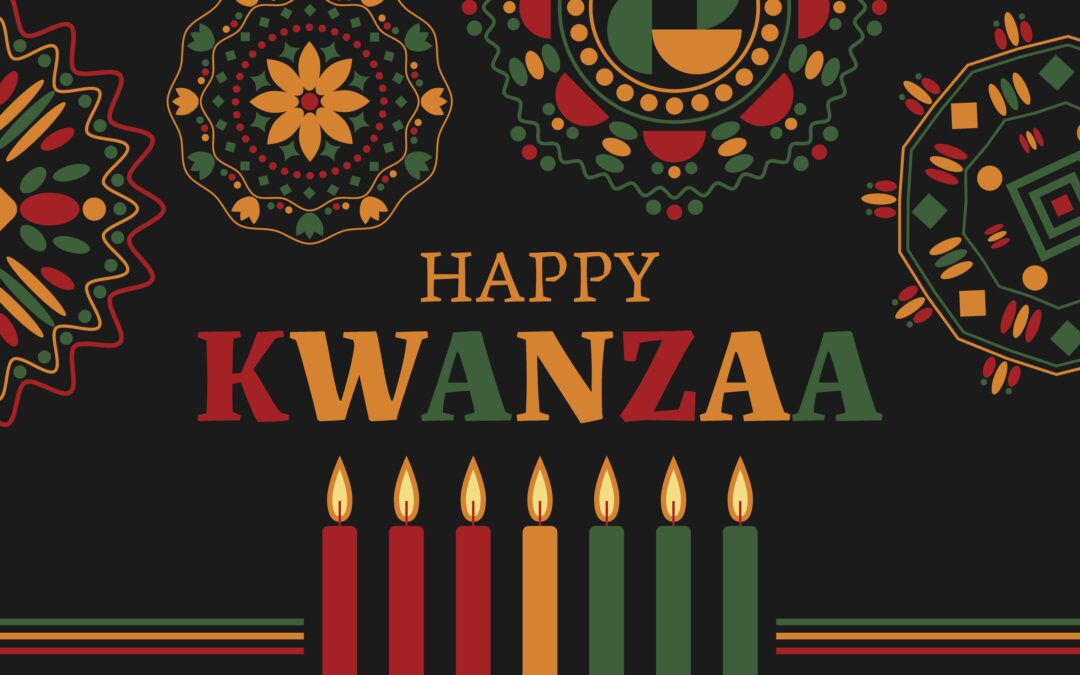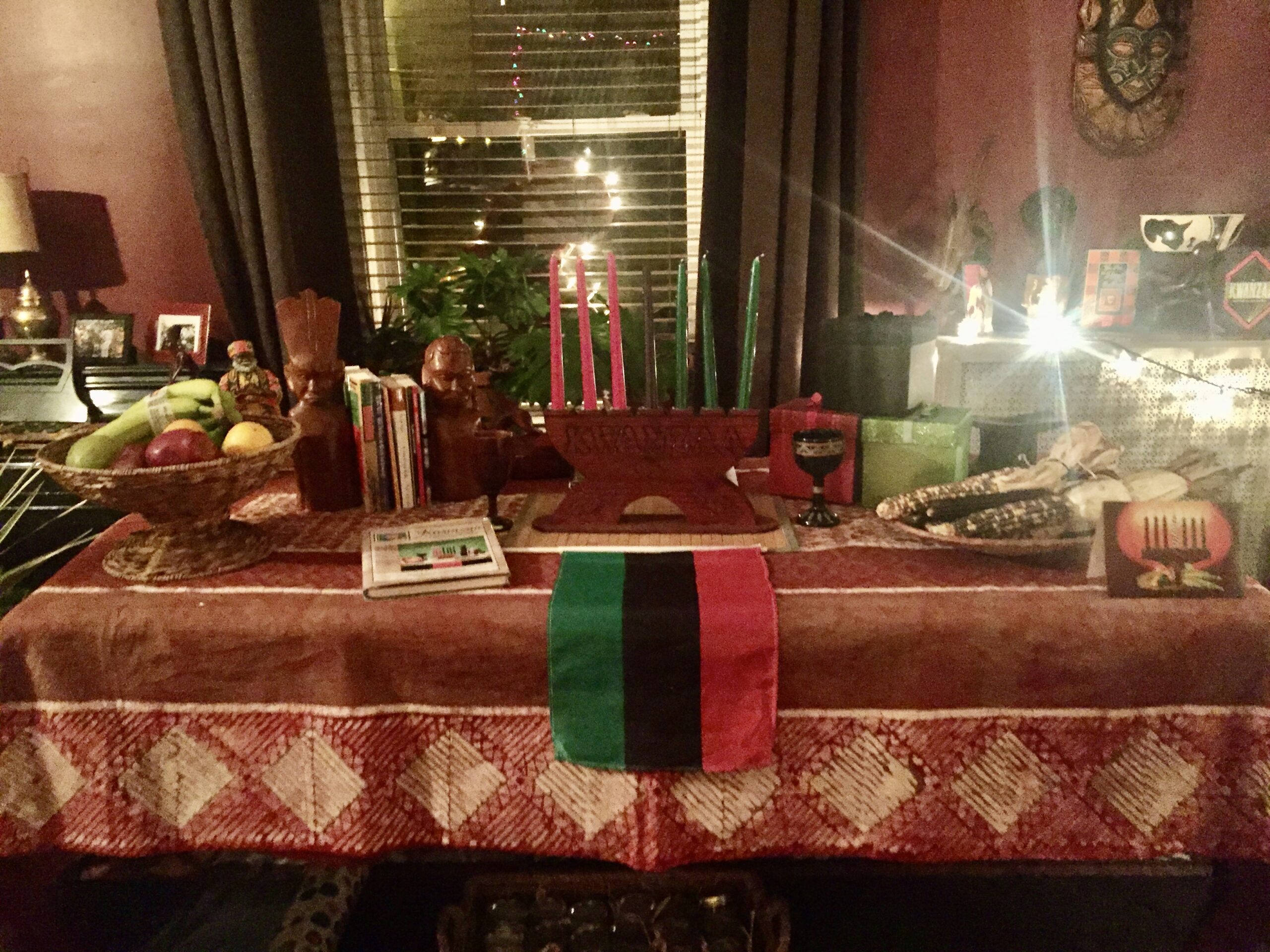
ORIGINS AND MEANING OF KWANZAA
Kwanzaa is a word that comes from the Swahili phrase, “matunda ya kwanza,” or “first fruits.” It refers to First Fruits or Harvest Festivals that are observed throughout the African Continent. The celebration of “Kwanzaa” was created in 1966 by Dr. Maulana Ron Karenga to affirm African culture and heritage.
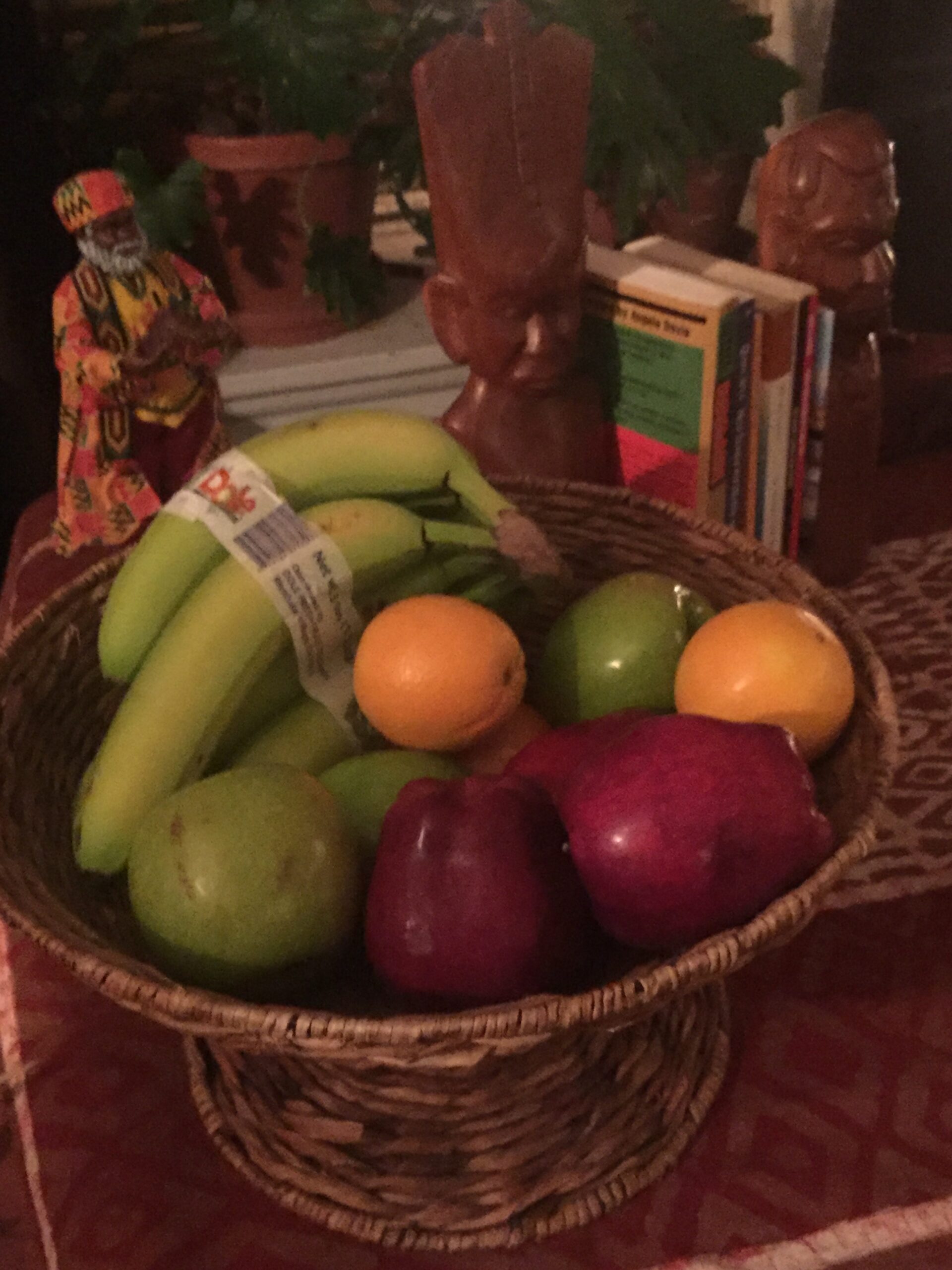
According to founder Dr. Karenga’s description on the official Kwanzaa website, the holiday “is a celebration of family, community, and culture. Kwanzaa’s origins are both ancient and modern and both sources serve to urge us to constantly strive and struggle to be ourselves and free ourselves, to live good lives and to bring forth the best of what it means to be African and human as both a personal and social practice.”
Another quote from Dr. Karenga states that: “This is our duty: to know our past and honor it, to engage our present and improve it, and to imagine a whole new future and forge it in the most ethical, effective and expansive ways.” Kwanzaa takes place over seven days annually from December 26th through January 1st. Each day represents one of Kwanzaa’s seven guiding principles. Although started in the United States, Kwanzaa is observed globally, throughout the African Diaspora.
SYMBOLS AND RITUALS OF KWANZAA
The seven principles of Kwanzaa are known as the Nguzo Saba. These principles exemplify the very best of African cultures and traditions throughout the Diaspora. Kwanzaa is celebrated to help people of African descent affirm the grandeur and beauty of our ancestral home and translate that beauty into our everyday lives. As mentioned earlier, the holiday, an East African Swahili word which, translated means “first fruits of the harvest,” was created by Dr. Maulana Karenga, professor and chair of the department of Africana Studies at California State University, Long Beach.
Dr. Karenga is the author of Kwanzaa’s authoritative book,
Kwanzaa: A Celebration of Family, Community, and Culture
To reiterate, the seven principles of Kwanzaa are known as the Nguzo Saba.
1. Umoja is the first principle of Kwanzaa and means unity.
2. The second principle is Kujichagulia; it means self-determination.
3. Ujima, the third principle means collective work and responsibility
4. Ujamaa the fourth principle represents cooperative economics.
5. Nia, the fifth principle, means purpose.
6. The sixth principle, Kuumba, stands for creativity.
7. Imani, the seventh principle, is faith.
During a celebration known as a karamu, it is typical for a table to be set up with various symbols that are associated with Kwanzaa. Like the principles, the symbols are also named in the Swahili language.
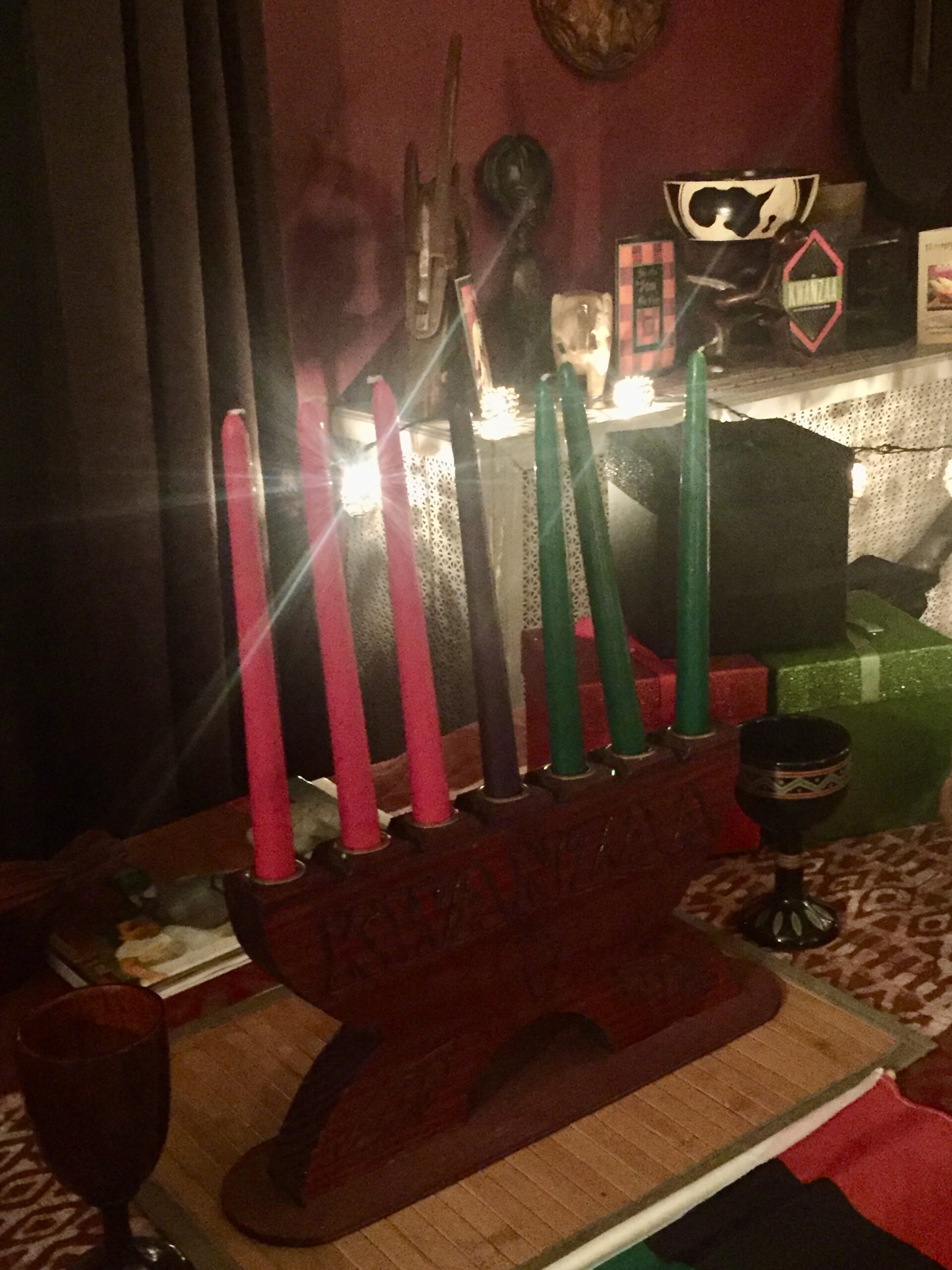
Mishumaa Saba, or the seven candles, are symbolic of the Nguzo Saba, each representing one of the seven principles of Kwanzaa. Three candles are red, there is one black candle in the center, and there are also three green candles.
The Kinara is the candle holder and symbolizes the roots of the African people. A candle is lit each night during Kwanzaa, focusing on the principle of the day.
Mazao, means the crop and symbolizes African harvest celebrations.
Mkeku, the mat, symbolizes the foundation on which to build.
Muhindi, which means the corn, is symbolic of children and the future.
Kikombe cha Umoja is the unity cup and is symbolic of Kwanzaa’s foundational principle of unity.
Zawadi means gifts and is symbolic of the labor and love of parents, and the commitments made and kept by children.
In addition to principles and symbols, there are also greetings associated with Kwanzaa. These greetings are also in Swahili. “Habari Gani?,” which means “How are you?” “What’s the word?” or “What’s the news?” is answered with the principle of the day. So on the first of the seven days, December 26th, “Habari Gani?” would be answered with “Umoja!” On the last day of Kwanzaa, January 1st, “Habari Gani?” would be answered with “Imani!” which means faith. “Harambee” means “all pull together.” “Harambee!” is often enthusiastically shouted seven times in unison at the end of formal Kwanzaa ceremonies after the kinara has been lit and observers have reflected on the past year.
PERSONAL REFLECTIONS ON KWANZAA
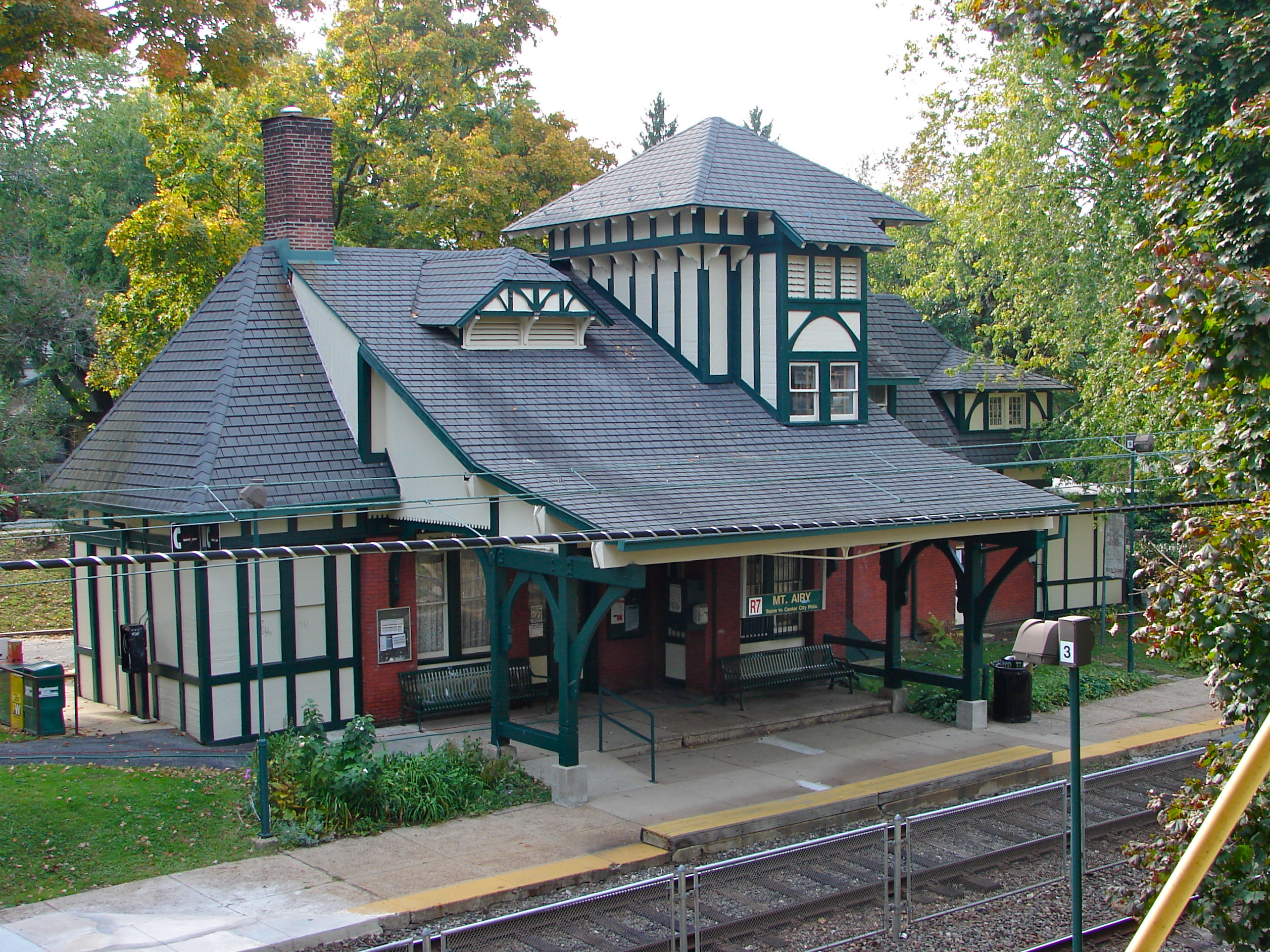
I first learned about Kwanzaa during the 1960s. However, more than a decade would pass before I actually began to observe the tradition. In 1964 our family moved from North Philadelphia to Sprague Street right across from the Mount Airy Regional Rail train station. We became life-long friends with The Parkinsons, our neighbors who lived two doors down from us. The Parkinsons, and us Doves were among the Black families on the block. Our integrated enclave of families on Sprague Street ranged from African American, to Filipino to Jewish – from Italian, to Irish to Icelandic, German, Dutch, and Lebanese. An Episcopalian priest and his family lived on our block, a Quaker family lived right next door to us, and there was a gay male couple who lived across the street. The four Parkinson children were close in age to us five Dove children.
Through hard work, intelligence, and sheer grit, The Reverend John A. Parkinson propelled himself from abject poverty in his homeland of Guyana, South America, to our lovely, pristine, tree-lined block in Mt. Airy. Mrs. Parkinson was from “The Bottom,” a proud albeit low income historically Black neighborhood in West Philadelphia. My parents had also escaped poverty. They were both born and raised in the cruel Jim Crow South, and had followed the great migration to Philadelphia from South Carolina during the 1950s. Even though my Dad was a highly sought after bricklayer, and my mother eventually went to night school and completed her bachelor’s degree in elementary education, at the time we moved to Sprague Street my parents were working class folks. In stark contrast, by the time we met them, Reverend and Mrs. Parkinson were educated people. They both had their bachelor’s degrees and Rev. Parkinson also had his master’s degree. Mrs. Parkinson, an English teacher, belonged to the AKA (Alpha Kappa Alpha) Sorority, and Rev. Parkinson, a Lutheran minister, belonged to the Alpha Phi Alpha Fraternity.
LEARNING ABOUT LIVING THE PRINCIPLES OF KWANZAA
In hindsight, I realize both my parents and the Parkinson’s were upwardly mobile Black people who were actively practicing multiple Kwanzaa principles. They practiced Umoja, Unity, Kujichagulia, Self-determination, Ujima, Collective Work and Responsibility, Nia, Purpose, and perhaps most importantly – Imani – Faith. They worked hard, sacrificed, budgeted their money, pooled their resources, and – against all odds – mortgaged homes in one of Philadelphia’s most beautiful neighborhoods. They determined they wanted to enroll their children in top public schools. They determined they wanted better lives for their children than they had experienced themselves. And, without looking back, they forged ahead to make it all happen.
Not only were the Parkinsons educated Black professionals, they were also politically active, and they were intellectuals. The Parkinsons’ home overflowed with books in every room, and they encouraged all of us to read widely. They had a spinet piano tucked away in the corner under the stairs of the living room, and their oldest son, Johnny, used to play popular music by ear. He would also crack jokes here and there as he sang and played beautiful spontaneous original tunes.
The Parkinsons had a cousin who was an artist. He was a tall, thin, light-skinned young man who was one of the few Black students at the Pennsylvania Academy of the Fine Arts. Whenever he came over, they would trace their familial roots back to North Carolina and South Carolina, as they intermittently discussed art, culture, and politics. One day he came over with a huge oil painting which he sold to them, and they hung it on the wall behind their living room sofa. Although I was only about 13 or 14 years old at the time, I was quite aware of what was going on. This was my first introduction to Black art being bought and sold and displayed prominently in a Black family’s home. Now I have come to understand that the Parkinson’s were actively engaged in the principle of Ujamaa – cooperative economics. The name of this artist is Richard Watson, and we have remained great friends over the decades. He was a cousin on Mrs. Parkinson’s side of the family – her maiden name was Willye Essie Watson.
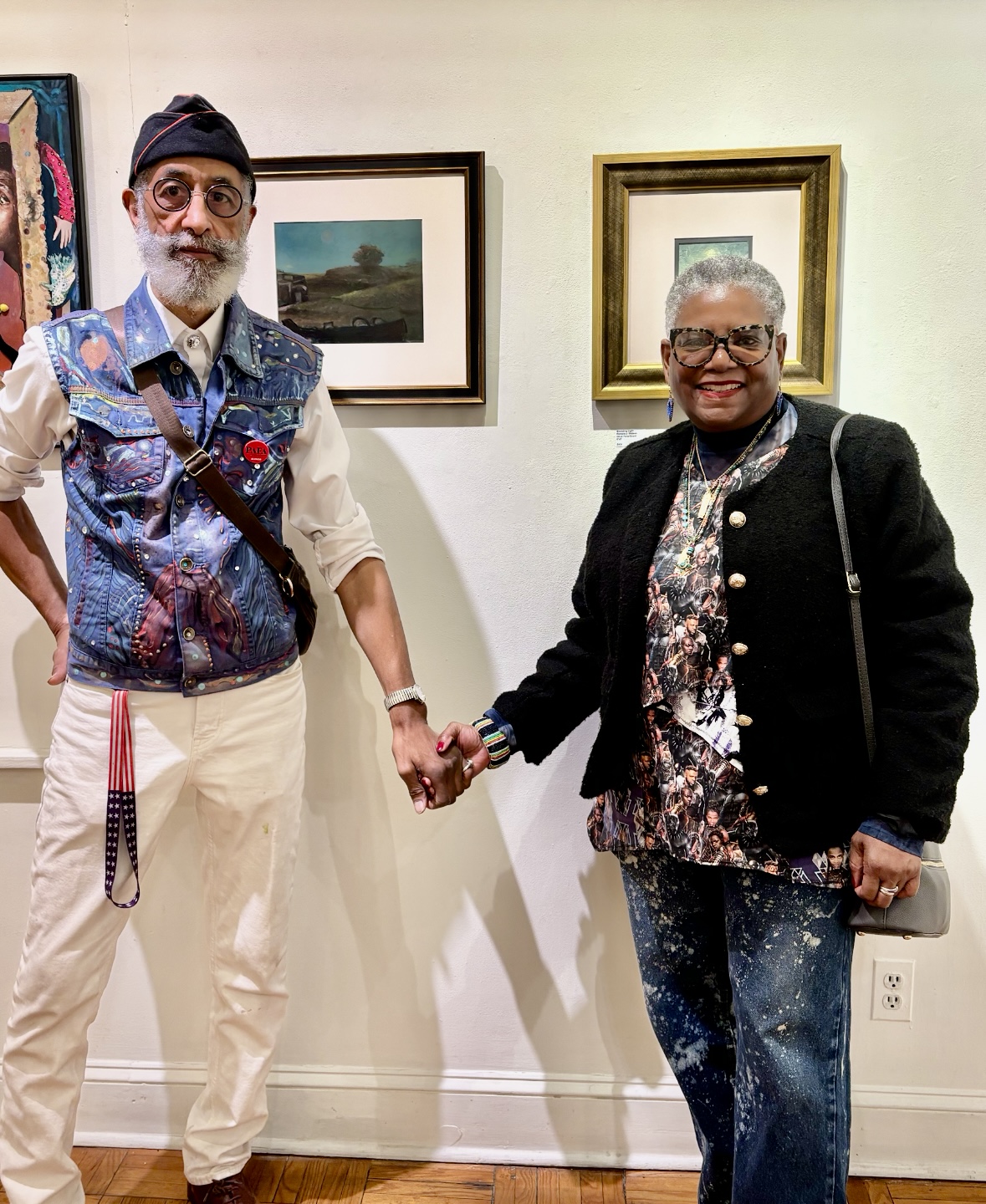
Richard Watson has become quite a renowned and prolific artist since he was a student at the Pennsylvania Academy of the Fine Arts. We met when I was growing up on Sprague Street in Mt. Airy and have remained great friends ever since.
Through the years, Richard Watson has become quite a renowned artist. In December of 2024, the Pew Center for Arts and Heritage awarded him with one of its highly esteemed “Philadelphia Cultural Treasures” fellowships. Richard Watson’s work is immortalized amongst the murals painted by various Black artists on the walls of the historic Church of the Advocate in North Philadelphia. He most definitely exemplifies Kuumba – creativity. For many years, Richard Watson has also served as the Curator in Residence for The African American Museum of Philadelphia. At the time of this writing in December, 2024, Rev. and Mrs. Parkinson, and my own parents Mr. and Mrs. Samuel C. Dove, Sr., and Esther Dingle Dove, have all gone home to glory – to their rewards in heaven. And sadly, it breaks my heart to acknowledge that Johnny Parkinson is also now our Ancestor. But Richard Watson’s painting remains. Currently it is hung in a place of honor in the beautiful family home of Jeffrey Parkinson, the youngest of the Parkinson siblings. Passing this painting down through the generations in the Parkinson family is an example of Nia, purpose.
Thinking back, I also vividly recall those times when my parents, and Rev. and Mrs. Parkinson would get into these lively discussions about the ongoing Civil Rights Movement, and burgeoning Black Arts Movement. They talked about Freedom Rides, Martin Luther King, Jr., SNCC (Student Nonviolent Coordinating Committee), CORE (The Congress of Racial Equality), the NAACP (National Association for the Advancement of Colored People) and even the Black Panthers.
The Parkinsons were in some of the same intellectual circles as Ron Karenga, who later became known as Dr. Maulana Karenga, the founder of Kwanzaa. The Parkinsons discussed this “holiday” in detail when it was first being proposed. At that young age, (I was 11 in 1966), I had to wonder why this “Black” holiday was juxtaposed so close to Christmas, and I was confused about if it was a religion. Were we all of a sudden being asked to abandon Christmas? And from listening to so many stories about Ron Karenga’s let’s say colorful personality, I began to question (in my mind) if this guy was some kind of nut. But because I was a child, with no business eavesdropping on grown folks’ conversation while my younger sisters Esther and Stephanie were upstairs in Carol Parkinson’s bedroom playing with her dolls, and Carol and I were in the kitchen, supposedly washing up the dishes, I had to keep my mind quiet, and my mouth shut. However eventually, by the time I graduated from Hampton Institute in 1977, a historically Black college in Hampton Virginia, I was well versed and deeply committed to observing Kwanzaa. To this day, I continue to aspire to live by the principles of Kwanzaa 365 days a year as a way of life.
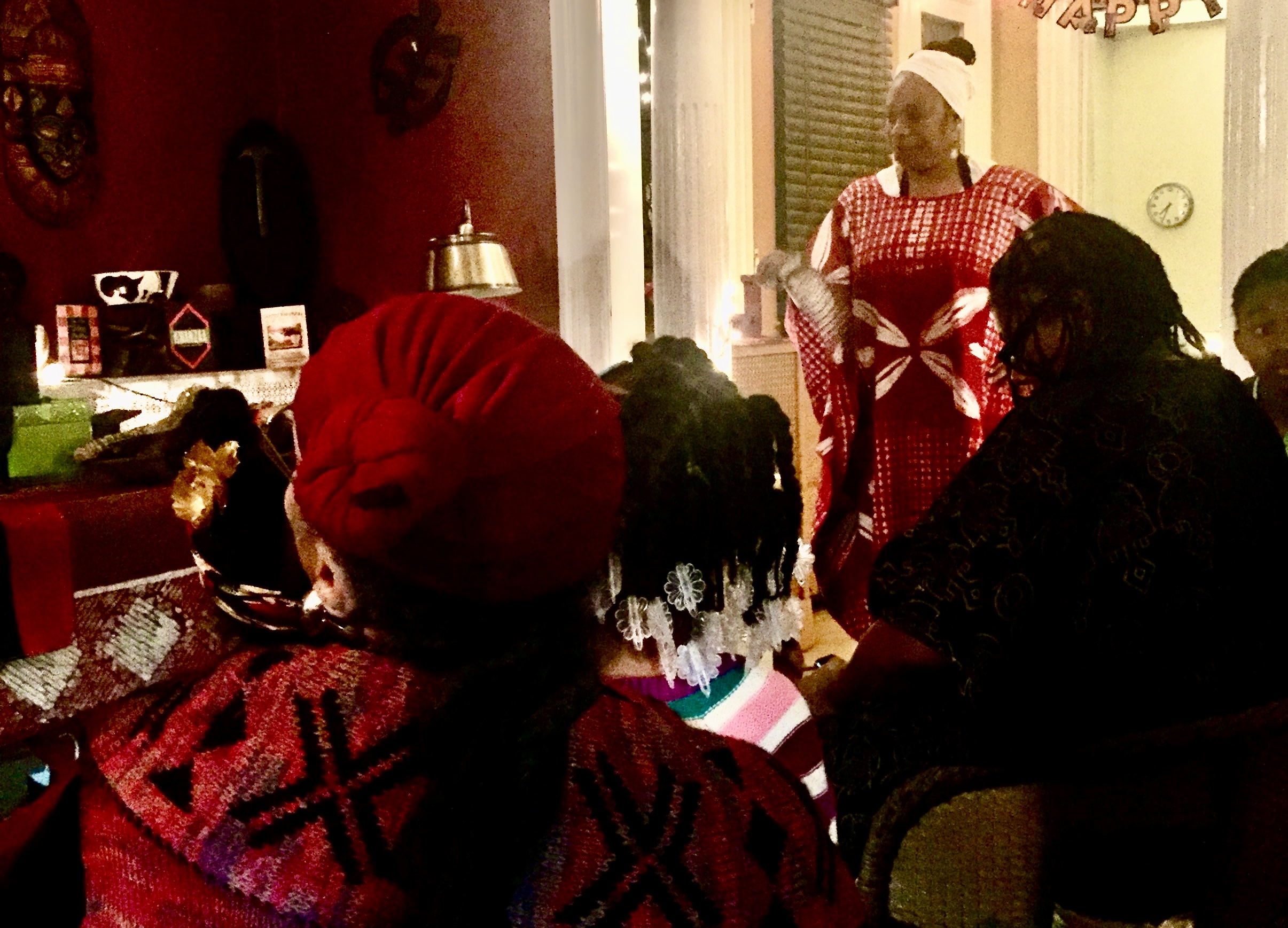
Kim Hall Jackson welcoming guests into her home during a Kwanzaa Karamu
HOSTING AN ANNUAL KWANZAA KARAMU
My dear friends and extended family Kim Hall Jackson and Jeffrey Jackson have hosted Kwanzaa Karamus in their Philadelphia home for more than 20 years. As many as 70 family members and friends have come together to participate in a festive atmosphere of African drumming, singing, dancing, laughing, talking, and enjoying an overflowing buffet of soul food (traditional African American cuisine), vegetarian dishes, and other specialties including Ethiopian chicken. Kim Hall Jackson explained that, “Kwanzaa is a non-religious, noncommercial African centered holiday with a focus on morals and values, building character, and having faith. It translates into everyday life. We start off the ceremony by asking for permission from the elders and pour libations for the Ancestors. We acknowledge positive things that happened to us over the past year. It is very powerful.”
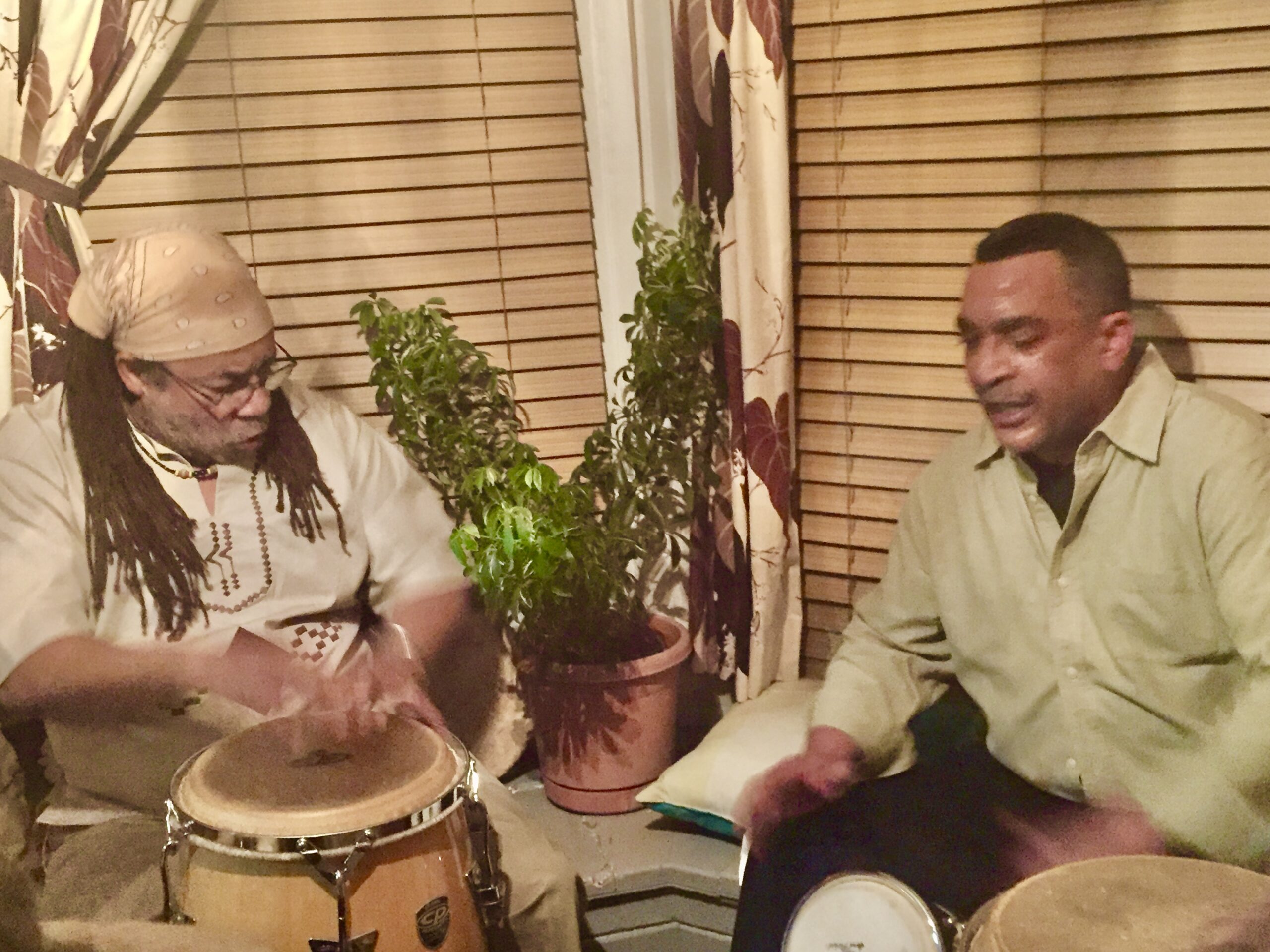
Jeffrey Jackson and Anthony Davis playing African drums during one of the Jackson family’s annual Kwanzaa Karamus
Jeff Jackson says families can observe Kwanzaa and prosper from following the holiday’s seven principles throughout the year. “The important thing about Kwanzaa is to emphasize these principles and get us as Black people to live principled lives.”
Kim Hall Jackson finds strength and meaning during this and every Kwanzaa season. “I give thanks every year. Because every year we go through something. Kwanzaa brings that village love, the togetherness of it, the community love of it, to celebrate our people. It’s all love, every year.” Kwanzaa is gaining more popularity each year throughout the Diaspora, in countries near and far, from Canada, to England, from Ghana, to Nigeria, and South Africa. There have even been U.S. postage stamps issued to commemorate the holiday. It’s no wonder Jeff Jackson and his wife host a karamu every year. He has been an ardent observer of Kwanzaa ever since his older brothers introduced him to the holiday in 1966 when it was created by Dr. Karenga. He sums up the spirit of this African-centered tradition: “It’s a lot of fun. It’s great to celebrate ourselves.” Celebrate ourselves indeed. Harambee!
~. ~. ~. ~. ~. ~. ~.
